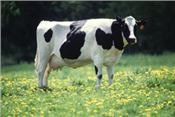Optimizing Oats For Use As Dairy Forage
BELTSVILLE, MD.
Wisconsin dairy producers are increasingly adopting a practice that makes economic and environmental sense: They plant oats in early to mid-August and either allow cattle to graze them through late November or harvest the crop in early November for later use. The strategy allows production of an additional forage crop before winter. The oats also “scavenge” excess nitrogen from the soil, and the plant residues enrich the soil.
Dairy producers, however, need guidance on when to allow their cattle to start grazing the fall oats and which oat cultivars to use. If they allow cattle to graze forage too early, the heifers quickly eat up whatever is available and get less forage than if the oats were given more time to grow. Putting the heifers out to graze later in the fall means running the risk of inclement weather and losing oats under snow cover.
Agricultural Research Service (ARS) dairy scientist Wayne Coblentz and his colleagues at the U.S. Dairy Forage Research Center planted two types of oat cultivars (an early- and a late-maturing variety) in August and put dairy heifers out to graze for six hours a day at two different starting dates: in late September and mid-October.
They weighed the cattle at the beginning and end of the grazing periods and evaluated the oats for their nutritional value and the amount of forage mass produced. All of the animal care and handling procedures were approved by a University of Wisconsin oversight committee.
After two years of grazing, the results showed that it’s better to put the cattle out early in the fall rather than later, and it often is better to use late-maturing cultivars. The heifers put out to graze early gained twice as much weight per day as the heifers put out later. The late-maturing oat variety also produced higher quality forage, with greater energy density in the plant stems and leaves, and greater concentrations of water-soluble carbohydrates that support cattle growth. The results should prove useful to Wisconsin’s $43.4-billion dairy industry. ∆

ARS scientists are helping dairy producers
determine optimal ways to produce
forage for their cattle.